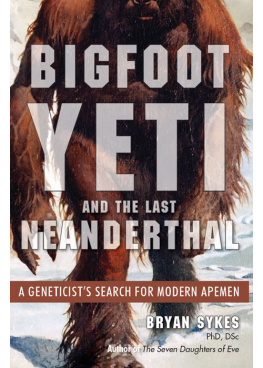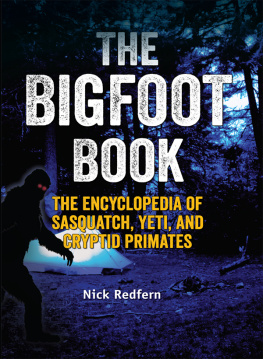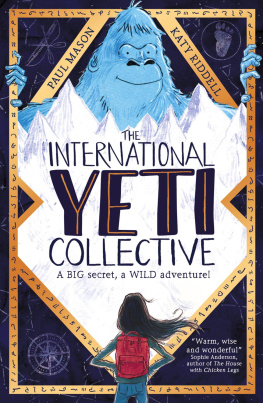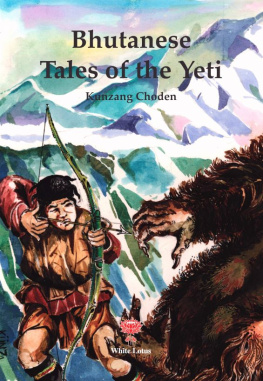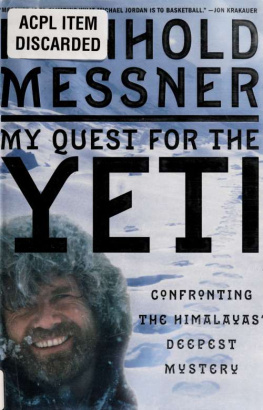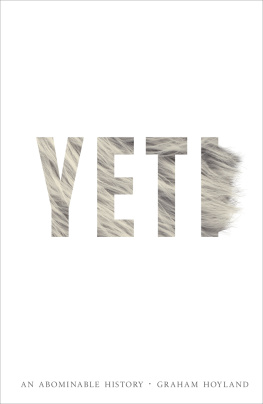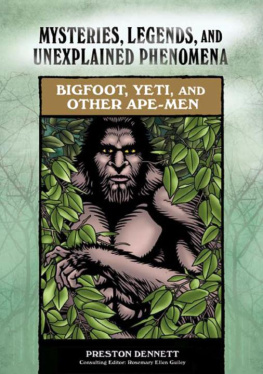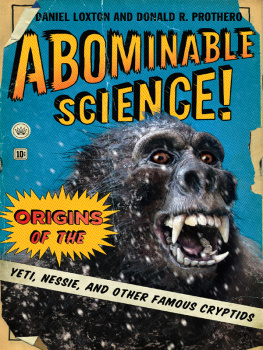
Published by Disinformation Books,
an imprint of
Red Wheel/Weiser, LLC
with offices at
65 Parker Street, Suite 7
Newburyport, MA 01950
www.redwheelweiser.com
Copyright 2016 by Bryan Sykes.
All rights reserved. No part of this publication may be reproduced or transmitted in any form or by any means, electronic or mechanical, including photocopying, recording, or by any information storage and retrieval system, without permission in writing from Red Wheel/Weiser, LLC. Reviewers may quote brief passages. Previously published in 2014 as The Nature of the Beast by Coronet, an imprint of Hodder & Stoughton, ISBN: 9781444791259.
ISBN: 978-1-938875-15-1
Library of Congress Cataloging-in-Publication data available upon request
Cover design by Jim Warner
Cover photograph: The Yeti, illustration from Monsters and Mythic Beasts, 1975 (colour litho), D'Achille, Gino (20th century) / Private Collection / Bridgeman Images
Printed in the United States of America
M&G
10 9 8 7 6 5 4 3 2 1
Disinformation is a registered trademark of The Disinformation Company Ltd.
www.redwheelweiser.com
www.redwheelweiser.com/newsletter
To Rhettman Mullis
A good man and a good friend
Contents
PART 1
1
The Big Guy

The following account is taken from my field notes of Sunday 18 March 2013
The events I am about to describe defy any rational explanation; something that as a scientist who believes in the triumph of reason over superstition, I find profoundly disturbing. The events occurred in the western margins of the northern Cascade Mountains about a hundred miles north of Seattle. I was taken there by Lori Simmons, a young woman in her thirties, who has dedicated a large part of her life to carrying on her late father Donald Wallace's work on a family of sasquatch. For the fifteen years before he died in 2010 he had lived deep in the forest a few miles from the small town of Marblemount, on the banks of the Skagit River. Lori had donated a clump of sasquatch hair found by her father to my research project, and I was keen to interview her and to see the area where the hair had been found.
We left the small town of Marblemount, Washington State, crossed the bridge over the Skagit River and drove along a narrow road through steep, forested slopes, only now and then glimpsing snow-covered peaks through gaps in the trees. After twenty miles or so we reached a point where a track led off to the right towards a campsite. We parked the car. It was completely silent. No breath of wind, no birdsong. A locked metal gate closed off access to the campground for the winter. We had to continue by foot.
On the way up to Marblemount, Lori and I had talked about precautions in case of a bear encounter. Black bears were common in the area and, in recent years, grizzlies had begun to drift down from British Columbia across the Canadian border, only sixty miles north. This year, with a mild winter, bears were coming out of hibernation earlier than usual. Opinions vary about what to do when meeting a bear, but Rhett, our other companion, was clearly taking the ultimate precaution as he strapped on his sidearm. All I carried was a puny Swiss Army knife.
We had stopped the car near a patch of old snow (which I checked for prints), eased ourselves around the gate and begun walking down the sloping track towards the campground. The underbrush was a mossy carpet punctuated by clumps of narrow-leaved ferns that had been flattened by recent snow. Tall fir trees stretched a hundred feet or more towards the sky. Beneath, spindly saplings struggled upward towards the light, their branches sleeved in the same green velvet moss that covered the ground. The forest was not dense, and the scene was bathed in an entrancing golden glow. To our right, about fifty yards distant, a small river tumbled down the mountainside and filled the wood with the gentle sounds of rushing water. A fallen trunk lay across our path, axe cuts showing that the park rangers had begun to clear the casualties of winter storms. Both Rhett and Lori examined the trees for signs of sasquatch, pointing out how the lower branches of the mossy trees bent downward, which they both attributed to long-term climbing by our mysterious friends. Similar explanations were given for the angle of other fallen trees and branches. Throughout, I said nothing, and saw nothing about the trees that could not be explained by completely ordinary events. I was just an observer, scanning the forest for signs of life, particularly bears, and keeping an open mind. I felt pleased to discover that although I was certainly alert, I was not unduly frightened. I made sure my voice recorder was working and my camera ready for instant action.
About a mile into the forest we came to our destination, a huge fir tree nearly thirty feet round at its base and well over a hundred feet tall. This, I was told, was the Big Guy's tree and he lived in a cave beneath it. The thought that I was in the company of the insane or deluded did flash across my mind. Lori had seemed perfectly normal when I met her in Burlington, and the three of us had chatted easily enough on the drive up the Skagit Valley to Marblemount. And yet here we were, in the middle of the forest, miles from anywhere, about to disturb what, if Lori and Rhett were right, was a very large and potentially very dangerous animal. Lori told me how she had been building a relationship with the Big Guy over several years, visiting this spot regularly, leaving green apples as gifts and engaging him in two-way conversations. She walked over the mossy ground to the base of the tree, all the time talking to the subterranean sasquatch as if it were a small child, pleading with it to respond. Not getting an answer from her voice alone, she stamped hard on the ground, but nothing happened. I watched this performance, not with silent mocking or wry amusement, but as an open-minded observer, a state of mind I tried to retain throughout the project.
Lori continued her monologue for perhaps five minutes, explaining to the Big Guy that she had brought two friends with her and that I had travelled all the way from England to meet him. In a mildly scolding tone she said how disappointed she was that he didn't want to play the knocking game today. We withdrew perhaps twenty yards up the road, Lori reasoning that a break might put him in a better mood and give him more time to wake up. She began to tell me how she had been introduced to the Big Guy by her father and how they had grown close over the years of her visits. Although she and the Big Guy had never seen each other, she had become increasingly aware of his amorous intentions towards her. She became convinced of this when she brought her new fianc to the gifting spot, whereupon the Big Guy had responded with more agitated knocking and fiercer growling than ever before.
Two or three minutes later we returned and Lori began her routine once again, stamping her foot on the ground. Again there was no response. Lori had with her a tape recorder with a parabolic microphone to record the Big Guy's various sounds but which could also transmit. She switched the recorder to PLAY mode and the voice of her father, long dead, drifted through the forest. He was reminiscing about his years in the woods, how he had first encountered the family of sasquatch who shared this remote place, how he had won their trust. Her father's familiar and reassuring voice had worked before, encouraging the Big Guy to respond with a knock or a growl. But not this time.
Next page
